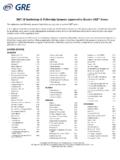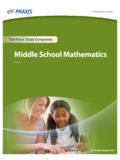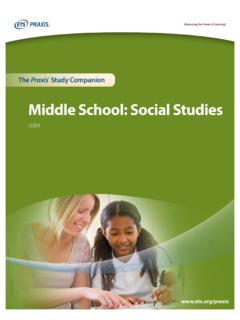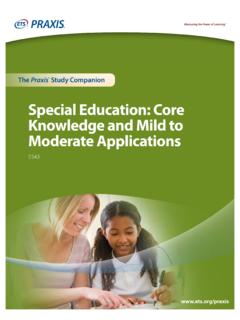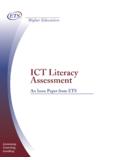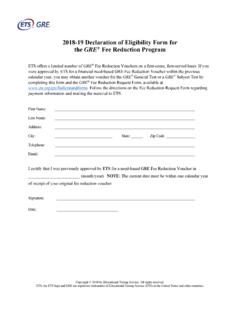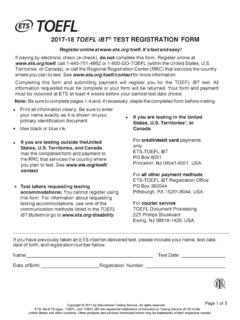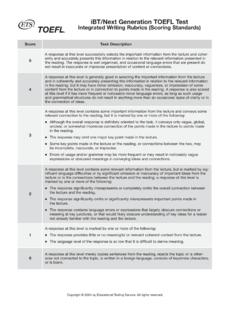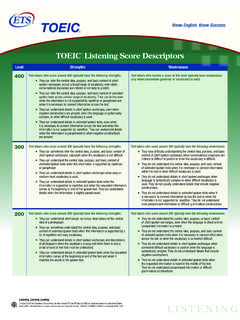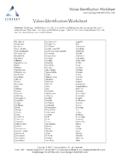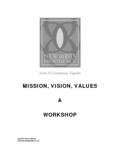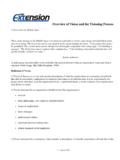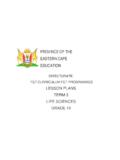Transcription of Become familiar with - ETS Home
1 GRE physics TestPractice BookThis practice book containsn one actual, full-length GRE physics Testn test-taking strategiesBecome familiar withn test structure and contentn test instructions and answering proceduresCompare your practice test results with the performance of those who took the test at a GRE of ContentsOverview ..3 Test Content ..3 Preparing for the Test ..4 Test-Taking Strategies ..4 What Your Scores Mean ..5 Taking the Practice Test ..5 Scoring the Practice Test ..5 Evaluating Your Performance ..5 Practice Test ..7 Worksheet for Scoring the Practice Test ..87 Score Conversion Table.
2 88 Answer Sheet ..89 Copyright 2017 by Educational Testing Service. All rights reserved. ETS, the ETS logo, MEASURING THE POWER OF LEARNING, GRADUATE RECORD EXAMINATIONS, and GRE are registered trademarks of Educational Testing Service (ETS) in the United States and other takers with disabilities or health-related needs who need test preparation materials in an alternate format should contact the ETS Office of Disability Services at For additional information, visit physics Test Practice Book 3 | PageOverviewThe GRE physics Test consists of about 100 multiple-choice questions. Testing time is 2 hours and 50 minutes; there are no separately-timed publication provides a comprehensive overview of the GRE physics Test to help you get ready for test day.
3 It is designed to help you: Understand what is being tested Gain familiarity with the question types Review test-taking strategies Understand scoring Practice taking the testTo learn more about the GRE Subject Tests, visit ContentThe test consists of approximately 100 five-choice questions, some of which are based on such materials as diagrams, graphs, experimental data and descriptions of physical situations. The aim of the test is to determine the extent of the test takers grasp of fundamental principles and their ability to apply these principles in the solution of problems. Most test questions can be answered on the basis of a mastery of the first three years of undergraduate physics .
4 The test questions are constructed to simplify mathematical manipulations. As a result, neither calculators nor tables of logarithms are needed. If the solution to a problem requires the use of logarithms, the necessary values are included with the question. The International System (SI) of units is used predominantly in the test. A table of information representing various physical constants and a few conversion factors among SI units is presented in the test book. Whenever necessary, additional values of physical constants are printed with the text of the approximate percentages of the test on the major content topics have been set by the committee of examiners, with input from a nationwide survey of undergraduate physics curricula.
5 The percentages reflect the committee s determination of the relative emphasis placed on each topic in a typical undergraduate program. These percentages are given below along with the major subtopics included in each content all the questions in the test will relate to material in this listing; however, there may be occasional questions on other topics not explicitly listed Classical Mechanics (20%)(such as kinematics, Newton s laws, work and energy, oscillatory motion, rotational motion about a fixed axis, dynamics of systems of particles, central forces and celestial mechanics, three-dimensional particle dynamics, Lagrangian and Hamiltonian formalism, non-inertial reference frames, elementary topics in fluid dynamics)II.
6 Electromagnetism (18%)(such as electrostatics, currents and DC circuits, magnetic fields in free space, Lorentz force, induction, Maxwell s equations and their applications, electromagnetic waves, AC circuits, magnetic and electric fields in matter)III. Optics and Wave Phenomena (9%) (such as wave properties, superposition, interference, diffraction, geometrical optics, polarization, Doppler effect)IV. Thermodynamics and Statistical Mechanics (10%)(such as the laws of thermodynamics, thermodynamic processes, equations of state, ideal gases, kinetic theory, ensembles, statistical concepts and calculation of thermodynamic quantities, thermal expansion and heat transfer)V.
7 Quantum Mechanics (12%)(such as fundamental concepts, solutions of the Schr dinger equation [including square wells, harmonic oscillators and hydrogenic atoms], spin, angular 4 | Page GRE physics Test Practice Bookmomentum, wave function symmetry, elementary perturbation theory)VI. Atomic physics (10%)(such as properties of electrons, Bohr model, energy quantization, atomic structure, atomic spectra, selection rules, black-body radiation, x-rays, atoms in electric and magnetic fields)VII. Special Relativity (6%)(such as introductory concepts, time dilation, length contraction, simultaneity, energy and momentum, four-vectors and Lorentz transformation, velocity addition)VIII.
8 Laboratory Methods (6%)(such as data and error analysis, electronics, instrumentation, radiation detection, counting statistics, interaction of charged particles with matter, lasers and optical interferometers, dimensional analysis, fundamental applications of probability and statistics)IX. Specialized Topics (9%)Nuclear and Particle physics (such as nuclear properties, radioactive decay, fission and fusion, reactions, fundamental properties of elementary particles), Condensed Matter (such as crystal structure, x-ray diffraction, thermal properties, electron theory of metals, semiconductors, superconductors), Miscellaneous (such as astrophysics, mathematical methods, computer applications)Preparing for the Test GRE Subject Test questions are designed to measure skills and knowledge gained over a long period of time.
9 Although you might increase your scores to some extent through preparation a few weeks or months before you take the test, last minute cramming is unlikely to be of further help. The following information may be helpful. A general review of your college courses is probably the best preparation for the test. However, the test covers a broad range of subject matter, and no one is expected to be familiar with the content of every question. Become familiar with the types of questions in the GRE physics Test, paying special attention to the directions. If you thoroughly understand the directions before you take the test, you will have more time during the test to focus on the questions themselves.
10 Test-Taking Strategies The questions in the practice test illustrate the types of multiple-choice questions in the test. When you take the actual test, you will mark your answers on a separate machine-scorable answer sheet. The following are some general test-taking strategies you may want to consider. Read the test directions carefully, and work as rapidly as you can without being careless. For each question, choose the best answer from the available options. All questions are of equal value; do not waste time pondering individual questions you find extremely difficult or unfamiliar. You may want to work through the test quickly, first answering only the questions about which you feel confident, then going back and answering questions that require more thought, and concluding with the most difficult questions if there is time.
